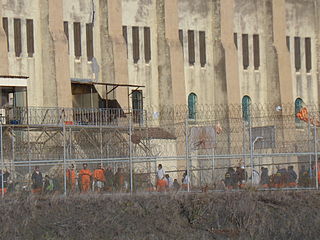SAN QUENTIN, CALIFORNIA — It has been said that casting a ritual circle describes a sacred place, outside of time and space. Whoever came up with that phrasing likely has never worked within the U.S. correctional system, where space is rigidly controlled by an unyielding culture and where time moves according to the whims of an incredibly complex bureaucracy.

San Quentin Prison yard [Photo Credit: Zboralski / via Wickimedia]
“There’s nothing that’s simple in prison bureaucracies,” she said during a recent phone interview. “It’s very bizarre, quite opaque, and in flux.”
The many regulations exist to keep staff and inmates safe and secure. But in a penitentiary system as large as California’s, and in a prison as old as San Quentin, those who aren’t part of the system would easily be confused by the dizzying number of requirements. In addition, the exact constitutional rights entitled to inmates — and in what form — are also moving targets, as court cases cause wardens to change tactics.
While others choose to fight those legal battles, O’Brien has been focusing on giving one group of Pagan men the opportunity to worship their gods. Many people find religion when they are incarcerated. A recent Chicago Tribune article provides an look at religious belief in prison and how that works from a inmate’s perspective.
Because so many are finding religion, education on the basics of ritual and practice are an implicit as part of O’Brien’s work. That is a challenging enough proposition for professional chaplain working in large churches, where presumably there’s a single set of beliefs and rituals to transmit. But trying to be an expert on all which falls under the Pagan umbrella is near impossible.
The group O’Brien works with identifies as Wicca, while she herself does not. The rituals, as she described them, are what many might think of as having a “generic” structure, including a cast circle, elemental correspondences with directions, and a focus on one or more deities that change from ritual to ritual. She stays with what she knows, which is decades of worshiping as an eclectic nature-based Witch, and has worked to improve the conditions under which these men follow her lead.
O’Brien described the so-called chapel for minority religions as a storeroom where the initial preparations of the space involve moving what’s inside to the edges so they have room to gather in a circle. They lean some of the furniture against the wall to muffle the sounds of the gospel choir practicing next door, which can be distracting. While prisoners are not permitted lighters or matches, the use of incense and candles is okay per the regulations of this particular facility, so securing more of these supplies quickly became a priority.

Aline “Macha” O’Brien
One of the barriers drawn by most correctional facilities is a demarcation between visitors and volunteers. Those who work in the system — the volunteers — are not permitted to have any kind of personal relationship with a prisoner, which includes visiting them during designated times, sending them correspondence, or otherwise engaging outside of the time and place of the volunteer work. Likewise, if one visits a prisoner, one cannot at the same time be cleared as a volunteer.
While it was not difficult to secure someone willing to donate the ritual materials, that donor could not be known to the men in any way. The person who finally agreed to make the donation was Matt Whealton, a member of the San Francisco-based Temple of Ra. “Having had a close family member in the penal system some years ago, I understand how much it can mean for inmates to get some kind of humanizing support from the wider world,” he explained. Given a list of needed supplies, it was Whealton’s job to order them from the approved supplier — in this case, AzureGreen in Massachusetts — and ensure that the necessary paperwork accompanied the order so it wouldn’t be cast into some kind of correctional-facility limbo upon arrival.
As O’Brien explained, getting to that point has been challenging. At first, it wasn’t even clear if the vendor was approved at all, because she couldn’t get the same answer from any two people. With the assistance of Rev. Patrick McCollum, she was able to confirm that piece, and worked up a supply list which, she said, “needed to get about six approval signatures” before they could proceed.
Whealton himself had to confirm in writing his intention to donate the supplies, then the fully-approved form had to be mailed back to him so that he could include it when he mailed payment. If the approval form isn’t in the package upon its arrival at San Quentin, the box won’t be waiting for O’Brien when she goes back to open it up.
The list of supplies is carefully scrutinized to weed out anything deemed contraband. Prisoners are not allowed items which can be used as weapons, such as brass candlesticks or anything made of glass. Nor can they be given images containing any amount of nudity, which rules out quite a bit of sacred imagery. O’ Brien must bring a lighter herself for the candles and incense. While she was able to secure permission to use some glass votive holders, they are locked up securely in the chaplain’s office when not in use.
Even once the supplies arrive, much of the work to provide further religious props come from O’Brien’s home printer, which churns out everything from appropriate deity images to seasonal decorations like eggs and holly.
To this longtime Witch, the constraints of the prison system can be imposing, but the bigger problem is on the horizon. As noted earlier, many inmates find religion in prison. O’Brien said, “When these people are released, they are going to seek out people in their new faith community, and those people won’t know anything of their backgrounds.”
Because of the rules prohibiting personal relationships, she herself knows nothing about the crimes that landed these men behind bars, nor anything about how that experience has shaped them. Because Paganism is not a monolithic body, and does not have much in the way of infrastructure, she fears that the community will be unprepared to work with this new population.
How these people, who have lived in a place where time crawls and space is cramped, will ultimately integrate into a community that seeks the mysteries beyond those limits remains to be seen.
The Wild Hunt is not responsible for links to external content.
To join a conversation on this post:
Visit our The Wild Hunt subreddit! Point your favorite browser to https://www.reddit.com/r/The_Wild_Hunt_News/, then click “JOIN”. Make sure to click the bell, too, to be notified of new articles posted to our subreddit.
O’Brien is doing some amazing work with these men. Good article!
Why has Pagan prison ministry and incarcerated Pagans become such a big deal in recent years?
In the U.S. at least, I attribute it to the growth of the number of Pagans overall, growth of awareness of Paganism in mainstream culture, and growth in the size of the prison population as a percentage of the entire population of the United States (compared to other industrial countries, the United States has an unusually large segment of its residents behind bars).
Decades ago, Pagans were so few in number and so scattered geographically that anyone willing and able to teach about pagan religions or lead ritual, focused on providing these services to free people. The overall growth in numbers of Pagans, and increasing availability of introductory information, allows leaders to specialize instead of doing a bit of everything, and to choose which populations they serve.
At the same time, efforts at public education and coalition building that various Pagan and witchcraft organizations and writers have been involved in for decades are bearing fruit. Government institutions are beginning to recognize that Pagan religions exist and have enforceable rights to the same First Amendment protections as other religions.
Finally, just like high school students, members of the armed services, and various other groups of people, prisoners have become aware of Pagan religious ideas and some are attracted to them. There probably also is a some spread from one to many by word of mouth and personal contact, as there is in any other group of people who spend a lot of time together (such as recruits living on a military base).
A growing demand for services and resources is coinciding with increased availability of those services.
To put it another way, when a social or cultural movement begins to be successful, it spreads beyond the group it was originally based in, and that is happening with some contemporary Pagan religions.
Thank you for your insight. You’re probably correct.
I recall that within the past few years, Witches & Pagans magazine seemed to devote a lot of time to this issue. I find it fairly repellant, and not particularly interesting. our comments have provided a good context for this issue, however. Thank you again.
The US incarcerates a higher percentage of its population than all other countries.
There is no reason to trust any statistics reported by a one party police state, and sometimes no other available source of data to check the government’s figures. My guess is that North Korea has a larger part of its population in prisons and labor camps than the United States. Your guess is as good as mine; there is no way to know for sure. That is why I limited my comparison to “other industrial countries.”
Thanks for this coverage, Terence. Lest anyone be misled by the fact that you said I’m not Wiccan, I am a Witch and Pagan.
Also want to give a shout-out to some other Pagans who’ve worked with inmates for a long time: Lisa Morgenstern, Joseph Nichter, and Robert Russell in California, Christopher Penczak in New Hampshire, Holli Emore in South Carolina, Kirk Thomas in Washington. Not all of them work with Wiccan inmates, per se, but also with Druids, Heathens, et al. Those I mention have ongoing regular ministries, some at more than one institution; others go into the prisons from time to time. There are Pagans who serve inmates in other states, but of course there’s no way I’d know all of them. In any case, I tip my pointy black hat to them.
I thought O’Brien was Wiccan? I was surprised to learn she isn’t. Anyways, I hope these men find support when the get released. It is getting really difficult to find support in recent years. Maybe it is just the area I live in. I have offered support to all come to me, but that has only been two people in the last eight years. There was one group that I was working with, but when their leader had some family problems to deal with, it fell apart.
It depends upon how one defines Wicca, Brian. From the outside, I am; I will accept that label in some circumstances. However, more strictly speaking, the traditions in which I am trained and initiated (Reclaiming and Anderson Feri) are Witchen. I identify broadly with much of the Pagan spectrum of religions.
As do I.
Thank you Terence for the article. I’d like to add that the supplies we got through this time weren’t the first and won’t be the last. I am committed to helping Macha and the San Quentin Circle on an ongoing basis. It takes time and continuity to build the community developing there.